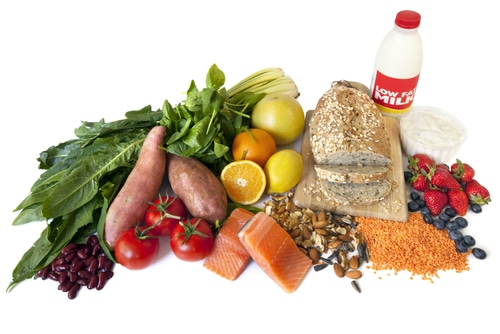
To determine a food’s glycemic index, researchers measure the glucose response that occurs when test subjects eat 50 grams of a carbohydrate-containing food. They compare this value to the same response after consuming pure glucose, where the glycemic index is set at 100. In actuality, glycemic index of a food is limited because it doesn’t tell you how much carbohydrate the food you’re testing contains.
Glycemic Load is a Better Measure
A better measure is the glycemic load. Glycemic load takes into account how many carbohydrates in food is actually available to the body. To calculate glycemic load, you divide a food’s glycemic index by 100 and multiply by grams of available carbohydrates. Available carbohydrate is the number of carbs left after subtracting out fiber. For example, raw carrots have a relatively high glycemic index by some measures, although this has been disputed recently, they don’t contain a lot of carbs. You’d have to eat more than 1.5 pounds of carrots to get 50 grams of carbs, so the glycemic load of carrots is low since most people don’t eat 1.5 pounds of carrots.
Factors That Affect Glycemic Index
The problem with the glycemic index is it varies depending upon what you eat a particular food with. If you eat a high-glycemic index food with one high in food or protein, it slows down digestion. This reduces the glycemic response so you don’t get the same spike in insulin. Individuals also digest food at different rates, which can affect the glycemic index of food. Acidic foods are also digested more slowly, so adding vinegar or lemon juice to food can reduce its glycemic response. Even the way food is cooked has an impact. For example, when you cook pasta longer, it softens it and increases its rate of absorption, while fiber makes food harder to absorb. Processed foods like white bread are more rapidly absorbed and have a higher glycemic index than unprocessed foods that contain more fiber.
Research looking at whether choosing foods based on their glycemic index helps with weight loss has been mixed. Regardless, using the glycemic index to determine your foods choices gets confusing because you have to know a food’s glycemic index and load, and it varies depending upon how you cook it, what you eat it with and how rapidly you digest and absorb it.
Why Bother with Glycemic Index and Glycemic Load?
Is there a better way? Simplify things by looking for foods that have a high-fiber content and are low in sugar and other calorie-containing sweeteners. Even better, eliminate most processed foods from your diet. Whole, fiber-rich foods typically have a low glycemic load, while most processed foods are altered so that they’re in a form that’s rapidly absorbed, which gives them a higher glycemic index.
As a general rule, you probably don’t need glycemic index or load to tell you that it’s healthy to replace white bread, white rice, and cereals with whole grains, to eat more nuts and beans and substitute fiber-rich vegetables for starchy ones. You also don’t need a book of glycemic indexes and loads to tell you to skip sugary pastries, cookies, cakes and soft drinks that have little nutritional value and lots of calories. Keep it simple by getting back to basic, whole foods that are naturally high in fiber and low in sugar. Why complicate things?
References:
Mayo Clinic. “Glycemic Index Diet: What’s Behind the Claims?”
American Journal of Epidemiology. 2009;169(6):667-677.
Related Articles By Cathe:
5 Whole Grains That Are Easy on Your Blood Sugar
Pastas Make You Fat – or Do They?
4 Types of Rice That Are Healthier Than White Rice
Coconut Sugar: a Healthy Alternative to Sugar or Not?
Good Carbs vs. Bad Carbs: Do You Know the Difference?

